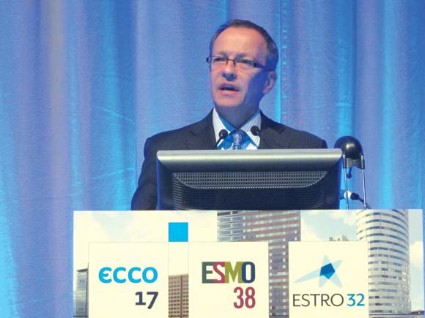User login
AMSTERDAM – Adding the investigational peptibody trebananib to weekly paclitaxel prolongs the time to disease progression or death in women with recurrent, advanced ovarian cancer, the phase III TRINOVA-1 trial has shown.
The primary endpoint of median progression-free survival was 7.2 months with paclitaxel plus trebananib and 5.4 months with paclitaxel (Abraxane) alone (hazard ratio, 0.66; P less than .001).
The beneficial effect of trebananib was seen across all prespecified subgroups including prior antiangiogenesis therapy, prior lines of therapy, platinum-free interval, bulky disease, ethnicity, and age, Dr. Bradley Monk said at the European Cancer Congress 2013.
Overall survival data are not expected to mature until 2014; however, an interim analysis with 50% of deaths indicates a nonsignificant trend in favor of the trebananib arm (19.0 months vs. 17.3 months; HR 0.86; P = .19), he said.
The results are intriguing because trebananib targets the angiopoietin axis, a new antiangiogenesis strategy in ovarian cancer that is not directed at the vascular endothelial growth factor (VEGF) receptor.
Instead, the recombinant peptide-Fc fusion protein, or peptibody, binds angiopoietin-1 and -2 with the Tie2 receptor, a signaling pathway that mediates vascular remodeling, explained Dr. Monk, a gynecologic oncologist at the University of Arizona Cancer Center, St. Joseph’s Hospital and Medical Center, Tucson, Ariz. Ang-1 and Ang-2 are associated with poor outcome in ovarian cancer.
Trebananib, formerly known as AMG 386, has shown single-agent activity in relapsed ovarian cancer in a phase I trial and prolonged progression-free survival in recurrent ovarian cancer in combination with paclitaxel in a randomized, phase II study.
The agent is also being studied in two ongoing phase III trials in combination with pegylated liposomal doxorubicin in recurrent ovarian cancer (TRINOVA-2) and in combination with first-line paclitaxel (Taxol) and carboplatin (Paraplatin) in newly diagnosed ovarian cancer (TRINOVA-3).
TRINOVA-1 enrolled 919 women with recurrent, partially platinum-sensitive or platinum-resistant epithelial ovarian cancer (91%), primary peritoneal cancer, or fallopian tube cancer. Patients were randomized 1:1 to weekly paclitaxel 80 mg/m2 plus placebo or weekly intravenous trebananib 15 mg/kg, which was 50% higher than the trebananib dose in the phase II study because of a signal that increased exposure increased efficacy, Dr. Monk said.
The women could have received up to three prior cytotoxic regimens; prior treatment with the VEGF-targeted monoclonal antibody bevacizumab (Avastin) was allowed. About half of the patients in each arm had a platinum-free interval of less than 6 months.
Adding trebananib to paclitaxel significantly improved the objective response rate from 29.8% with paclitaxel alone to 38.4% (P = .007), Dr. Monk said. Of the 435 trebananib patients, 17 (4%) had complete responses, 150 had partial responses (35%), and 159 had stable disease (37%), he reported at the multidisciplinary European cancer congresses.
Adverse event–related treatment discontinuations were higher with trebananib than with paclitaxel alone (17% vs. 6%).
The major toxicity seen with trebananib was edema, experienced at any grade by 57% of patients versus 26% of controls, with grade 3 or higher edema seen in only 5% vs. 1%, he said. There was no significant increase in the other adverse events generally seen with paclitaxel, such as grade 3 nausea (2% vs. 1%), alopecia (0% vs. less than 1%), and diarrhea (2% vs. 3%).
Further, trebananib did not increase the constellation of adverse events typically seen with anti-VEGF inhibition. Though there were some numeric differences between the control and trebananib arms in hypertension (4% vs. 6%) and GI perforation (less than 1% vs. 1%), "I think you get the sense that there really is not the signal of anti-VEGF–associated adverse events with trebananib that you’re accustomed to," Dr. Monk said.
There was no difference in patient-reported quality of life, "neither a detriment nor an improvement," on three different instruments, he said.
Invited discussant Dr. Antonio Casado, with San Carlos University Hospital, Madrid, said patients with prior bevacizumab appear to derive a similar benefit from trebananib, but the numbers were too small, at just 72 patients, to draw conclusions.
He went on to say that patients who relapse on bevacizumab will be increasingly seen in everyday clinical practice, making the identification of mechanisms to overcome resistance essential. Preclinical observations raise the possibility that Ang-1/Tie-2 activation may function to support tumor vasculature in the specific context of VEGF blockade, suggesting that sequential use of bevacizumab and trebananib could be a potential strategy to overcome resistance.
Dr. Monk reported that his institution has received research funding from Amgen, which sponsored the trial.
AMSTERDAM – Adding the investigational peptibody trebananib to weekly paclitaxel prolongs the time to disease progression or death in women with recurrent, advanced ovarian cancer, the phase III TRINOVA-1 trial has shown.
The primary endpoint of median progression-free survival was 7.2 months with paclitaxel plus trebananib and 5.4 months with paclitaxel (Abraxane) alone (hazard ratio, 0.66; P less than .001).
The beneficial effect of trebananib was seen across all prespecified subgroups including prior antiangiogenesis therapy, prior lines of therapy, platinum-free interval, bulky disease, ethnicity, and age, Dr. Bradley Monk said at the European Cancer Congress 2013.
Overall survival data are not expected to mature until 2014; however, an interim analysis with 50% of deaths indicates a nonsignificant trend in favor of the trebananib arm (19.0 months vs. 17.3 months; HR 0.86; P = .19), he said.
The results are intriguing because trebananib targets the angiopoietin axis, a new antiangiogenesis strategy in ovarian cancer that is not directed at the vascular endothelial growth factor (VEGF) receptor.
Instead, the recombinant peptide-Fc fusion protein, or peptibody, binds angiopoietin-1 and -2 with the Tie2 receptor, a signaling pathway that mediates vascular remodeling, explained Dr. Monk, a gynecologic oncologist at the University of Arizona Cancer Center, St. Joseph’s Hospital and Medical Center, Tucson, Ariz. Ang-1 and Ang-2 are associated with poor outcome in ovarian cancer.
Trebananib, formerly known as AMG 386, has shown single-agent activity in relapsed ovarian cancer in a phase I trial and prolonged progression-free survival in recurrent ovarian cancer in combination with paclitaxel in a randomized, phase II study.
The agent is also being studied in two ongoing phase III trials in combination with pegylated liposomal doxorubicin in recurrent ovarian cancer (TRINOVA-2) and in combination with first-line paclitaxel (Taxol) and carboplatin (Paraplatin) in newly diagnosed ovarian cancer (TRINOVA-3).
TRINOVA-1 enrolled 919 women with recurrent, partially platinum-sensitive or platinum-resistant epithelial ovarian cancer (91%), primary peritoneal cancer, or fallopian tube cancer. Patients were randomized 1:1 to weekly paclitaxel 80 mg/m2 plus placebo or weekly intravenous trebananib 15 mg/kg, which was 50% higher than the trebananib dose in the phase II study because of a signal that increased exposure increased efficacy, Dr. Monk said.
The women could have received up to three prior cytotoxic regimens; prior treatment with the VEGF-targeted monoclonal antibody bevacizumab (Avastin) was allowed. About half of the patients in each arm had a platinum-free interval of less than 6 months.
Adding trebananib to paclitaxel significantly improved the objective response rate from 29.8% with paclitaxel alone to 38.4% (P = .007), Dr. Monk said. Of the 435 trebananib patients, 17 (4%) had complete responses, 150 had partial responses (35%), and 159 had stable disease (37%), he reported at the multidisciplinary European cancer congresses.
Adverse event–related treatment discontinuations were higher with trebananib than with paclitaxel alone (17% vs. 6%).
The major toxicity seen with trebananib was edema, experienced at any grade by 57% of patients versus 26% of controls, with grade 3 or higher edema seen in only 5% vs. 1%, he said. There was no significant increase in the other adverse events generally seen with paclitaxel, such as grade 3 nausea (2% vs. 1%), alopecia (0% vs. less than 1%), and diarrhea (2% vs. 3%).
Further, trebananib did not increase the constellation of adverse events typically seen with anti-VEGF inhibition. Though there were some numeric differences between the control and trebananib arms in hypertension (4% vs. 6%) and GI perforation (less than 1% vs. 1%), "I think you get the sense that there really is not the signal of anti-VEGF–associated adverse events with trebananib that you’re accustomed to," Dr. Monk said.
There was no difference in patient-reported quality of life, "neither a detriment nor an improvement," on three different instruments, he said.
Invited discussant Dr. Antonio Casado, with San Carlos University Hospital, Madrid, said patients with prior bevacizumab appear to derive a similar benefit from trebananib, but the numbers were too small, at just 72 patients, to draw conclusions.
He went on to say that patients who relapse on bevacizumab will be increasingly seen in everyday clinical practice, making the identification of mechanisms to overcome resistance essential. Preclinical observations raise the possibility that Ang-1/Tie-2 activation may function to support tumor vasculature in the specific context of VEGF blockade, suggesting that sequential use of bevacizumab and trebananib could be a potential strategy to overcome resistance.
Dr. Monk reported that his institution has received research funding from Amgen, which sponsored the trial.
AMSTERDAM – Adding the investigational peptibody trebananib to weekly paclitaxel prolongs the time to disease progression or death in women with recurrent, advanced ovarian cancer, the phase III TRINOVA-1 trial has shown.
The primary endpoint of median progression-free survival was 7.2 months with paclitaxel plus trebananib and 5.4 months with paclitaxel (Abraxane) alone (hazard ratio, 0.66; P less than .001).
The beneficial effect of trebananib was seen across all prespecified subgroups including prior antiangiogenesis therapy, prior lines of therapy, platinum-free interval, bulky disease, ethnicity, and age, Dr. Bradley Monk said at the European Cancer Congress 2013.
Overall survival data are not expected to mature until 2014; however, an interim analysis with 50% of deaths indicates a nonsignificant trend in favor of the trebananib arm (19.0 months vs. 17.3 months; HR 0.86; P = .19), he said.
The results are intriguing because trebananib targets the angiopoietin axis, a new antiangiogenesis strategy in ovarian cancer that is not directed at the vascular endothelial growth factor (VEGF) receptor.
Instead, the recombinant peptide-Fc fusion protein, or peptibody, binds angiopoietin-1 and -2 with the Tie2 receptor, a signaling pathway that mediates vascular remodeling, explained Dr. Monk, a gynecologic oncologist at the University of Arizona Cancer Center, St. Joseph’s Hospital and Medical Center, Tucson, Ariz. Ang-1 and Ang-2 are associated with poor outcome in ovarian cancer.
Trebananib, formerly known as AMG 386, has shown single-agent activity in relapsed ovarian cancer in a phase I trial and prolonged progression-free survival in recurrent ovarian cancer in combination with paclitaxel in a randomized, phase II study.
The agent is also being studied in two ongoing phase III trials in combination with pegylated liposomal doxorubicin in recurrent ovarian cancer (TRINOVA-2) and in combination with first-line paclitaxel (Taxol) and carboplatin (Paraplatin) in newly diagnosed ovarian cancer (TRINOVA-3).
TRINOVA-1 enrolled 919 women with recurrent, partially platinum-sensitive or platinum-resistant epithelial ovarian cancer (91%), primary peritoneal cancer, or fallopian tube cancer. Patients were randomized 1:1 to weekly paclitaxel 80 mg/m2 plus placebo or weekly intravenous trebananib 15 mg/kg, which was 50% higher than the trebananib dose in the phase II study because of a signal that increased exposure increased efficacy, Dr. Monk said.
The women could have received up to three prior cytotoxic regimens; prior treatment with the VEGF-targeted monoclonal antibody bevacizumab (Avastin) was allowed. About half of the patients in each arm had a platinum-free interval of less than 6 months.
Adding trebananib to paclitaxel significantly improved the objective response rate from 29.8% with paclitaxel alone to 38.4% (P = .007), Dr. Monk said. Of the 435 trebananib patients, 17 (4%) had complete responses, 150 had partial responses (35%), and 159 had stable disease (37%), he reported at the multidisciplinary European cancer congresses.
Adverse event–related treatment discontinuations were higher with trebananib than with paclitaxel alone (17% vs. 6%).
The major toxicity seen with trebananib was edema, experienced at any grade by 57% of patients versus 26% of controls, with grade 3 or higher edema seen in only 5% vs. 1%, he said. There was no significant increase in the other adverse events generally seen with paclitaxel, such as grade 3 nausea (2% vs. 1%), alopecia (0% vs. less than 1%), and diarrhea (2% vs. 3%).
Further, trebananib did not increase the constellation of adverse events typically seen with anti-VEGF inhibition. Though there were some numeric differences between the control and trebananib arms in hypertension (4% vs. 6%) and GI perforation (less than 1% vs. 1%), "I think you get the sense that there really is not the signal of anti-VEGF–associated adverse events with trebananib that you’re accustomed to," Dr. Monk said.
There was no difference in patient-reported quality of life, "neither a detriment nor an improvement," on three different instruments, he said.
Invited discussant Dr. Antonio Casado, with San Carlos University Hospital, Madrid, said patients with prior bevacizumab appear to derive a similar benefit from trebananib, but the numbers were too small, at just 72 patients, to draw conclusions.
He went on to say that patients who relapse on bevacizumab will be increasingly seen in everyday clinical practice, making the identification of mechanisms to overcome resistance essential. Preclinical observations raise the possibility that Ang-1/Tie-2 activation may function to support tumor vasculature in the specific context of VEGF blockade, suggesting that sequential use of bevacizumab and trebananib could be a potential strategy to overcome resistance.
Dr. Monk reported that his institution has received research funding from Amgen, which sponsored the trial.
AT THE EUROPEAN CANCER CONGRESS 2013
Major finding: Progression-free survival was 7.2 months with paclitaxel plus trebananib vs. 5.4 months with paclitaxel alone (HR, 0.66; P less than .001).
Data source: A double-blind, prospective phase III study in 919 women with recurrent, advanced epithelial ovarian, primary peritoneal, or fallopian tube cancer.
Disclosures: Dr. Monk reported that his institution has received research funding from Amgen, which sponsored the trial.


